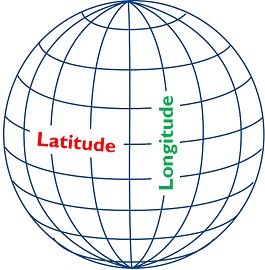 Latitude alludes to the horizontal lines that represent the distance of any point, north or south of the equator, its direction is east to west. On the other hand, longitude implies the vertical lines indicating the distance of any point, east or west of the prime meridian, its direction is north to south. Latitudes are also known as parallels while longitudes are termed as meridians.
Latitude alludes to the horizontal lines that represent the distance of any point, north or south of the equator, its direction is east to west. On the other hand, longitude implies the vertical lines indicating the distance of any point, east or west of the prime meridian, its direction is north to south. Latitudes are also known as parallels while longitudes are termed as meridians.
On earth’s surface, locations are determined by the two reference lines known as latitude and longitude. In fact, these are the ‘geographical coordinates’ which are used by a pilot and the ship captain, to indicate the position on the map. So, take a read of this article that sheds light on the difference between latitude and longitude.
Content: Latitude Vs Longitude
Comparison Chart
| Basis for Comparison | Latitude | Longitude |
|---|---|---|
| Meaning | Latitude implies the geographic coordinate which determines the distance of a point, north-south of the equator. | Longitude alludes to the geographic coordinate, which identifies the distance of a point, east-west of the Prime Meridian. |
| Direction | East to west | North to south |
| Symbol | Greek letter ɸ (phi) | Greek letter λ (lambda) |
| Stretches from | 0 to 90° | 0 to 180° |
| Lines of reference | Known as parallels | Known as meridians |
| Number of lines | 180 | 360 |
| Length of lines | Different | Same |
| Parallel | Yes, the lines are parallel. | No, the lines are not parallel. |
| Classifies | Heat Zones | Time Zones |
Definition of Latitude
In geography, latitude is defined as the angular distance of any point, north or south of the equator, i.e. it is a coordinate system, that is used as a reference point to locate places on earth.
An equator is an imaginary circular line drawn on the earth, which divides it into two equal parts, wherein the upper half is called Northern Hemisphere, and the lower half is known as Southern Hemisphere. The circular lines, parallel to the equator, up to the North and South poles are the parallels of latitude.
Latitude ranges from 0 degrees to 90 degrees, wherein equator indicates 0° latitude and 90° is at the poles. The parallels lying in the northern hemisphere are considered as north latitudes, while those lying in the southern hemisphere are called south hemisphere. Some major parallels of latitude are:
- Tropic of Cancer (23.5° N)
- Tropic of Capricorn (23.5° S)
- Arctic Circle (66.5° N)
- Antarctic Circle (66.5° S)
Definition of Longitude
The angular distance of any point, east or west of the Prime Meridian or west of the Standard Meridian is called longitude. It ascertains how far a particular place is, from the reference line. The reference lines passing from north pole to the south pole is known as meridians of longitude. These are semi-circles, whose distance decreases firmly polewards, as they all meet at the poles.
All the meridians are of the same length, and so Greenwich Meridian is considered as the Prime Meridian to number meridians. The value of prime meridian is 0° longitude and separate the earth into two equal parts, i.e. Eastern Hemisphere and Western Hemisphere.
Key Differences Between Latitude and Longitude
The points presented below are noteworthy, so far as the difference between latitude and longitude is concerned:
- The geographic coordinates which ascertain the distance of a point, north-south of the equator, is called latitude. The geographic coordinate, which identifies the distance of a point, east-west of the Prime Meridian, is termed as longitude.
- The direction of latitude is east to west, which is parallel to the equator. On the contrary, the direction of longitude is north to south, intersecting the two poles.
- Greek letter phi (ɸ) is used to represent latitude. Conversely, Greek letter lambda (λ), is a symbol for longitude.
- The range of latitudes is from 0 to 90 degrees, but the longitudes range from 0 to 180 degrees.
- The parallel circles from the equator to the north and south poles are termed as parallels of latitude. As opposed, the lines of reference, running from the two poles is known as meridians of longitude.
- The total number of latitude lines are 180. Unlike, there are a total number of 360 longitude lines.
- The parallels of latitude are of unequal length, whereas the meridians of longitude are of equal length.
- In latitude, the lines of references are parallel to each other. On the flip side, in longitude, the lines of references are not parallel to each other.
- Latitudes are used to categorise heat zones, i.e. torrid zone, temperate zone and frigid zone. In contrast, longitudes are used to classify time zones.
Conclusion
The surface of the earth is vast enough that it was difficult to locate any point, without the utilisation of the mathematical method. For this purpose, fictional lines are drawn on the globe, known as latitude and longitude. Both the latitude and longitude are imaginary lines, which are used to locate points on the earth’s surface, measured in degrees.






Michael says
Thanks for the assistance
mavallurumanaswi says
its really good
thankyou
very much
sati says
this is great
saifullahi Ibrahim says
nice
zara says
this is nice
Okorie Kalu Esther Chidubem says
Good
Mitchell says
Thanks, it really helped